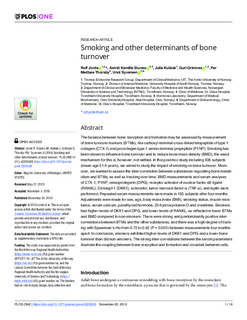| dc.description.abstract | The balance between bone resorption and formation may be assessed by measurement of bone turnover markers (BTMs), like carboxyl-terminal cross-linked telopeptide of type 1 collagen (CTX-1) and procollagen type 1 amino-terminal propeptide (P1NP). Smoking has been shown to influence bone turnover and to reduce bone mass density (BMD), the exact mechanism for this is, however, not settled. In this post-hoc study including 406 subjects (mean age 51.9 years), we aimed to study the impact of smoking on bone turnover. Moreover, we wanted to assess the inter-correlation between substances regulating bone metabolism and BTMs, as well as tracking over time. BMD measurements and serum analyses of CTX-1, P1NP, osteoprotegerin (OPG), receptor activator of nuclear factor ĸB ligand (RANKL), Dickkopf-1 (DKK1), sclerostin, tumor necrosis factor-α (TNF-α), and leptin were performed. Repeated serum measurements were made in 195 subjects after four months. Adjustments were made for sex, age, body mass index (BMI), smoking status, insulin resistance, serum calcium, parathyroid hormone, 25-hydroxyvitamin D and creatinine. Smokers had higher levels of DKK1 and OPG, and lower levels of RANKL, as reflected in lower BTMs and BMD compared to non-smokers. There were strong and predominantly positive inter-correlations between BTMs and the other substances, and there was a high degree of tracking with Spearman’s rho from 0.72 to 0.92 (P < 0.001) between measurements four months apart. In conclusion, smokers exhibited higher levels of DKK1 and OPG and a lower bone turnover than did non-smokers. The strong inter-correlations between the serum parameters illustrate the coupling between bone resorption and formation and crosstalk between cells. | nb_NO |

